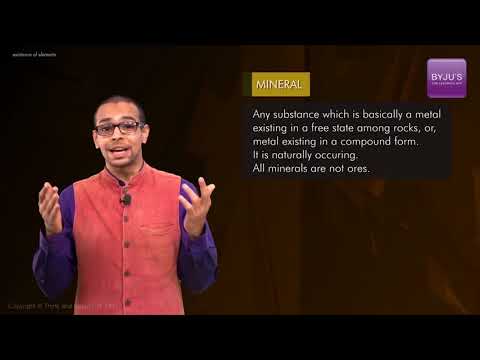Minerals Definition
Mineral is a naturally occurring inorganic solid with a definite chemical composition and a crystalline structure.
The earth is composed of mineral elements, either alone or in a myriad of combinations called compounds. A mineral is composed of a single element or compound. By definition, a mineral is a naturally occurring inorganic substance with a definite chemical composition and ordered atomic structure.
Table of Contents
Recommended Video on Minerals

Examples of Minerals
-
-
-
- Table salt is a mineral called sodium chloride. Its ordered structure is apparent because it occurs in crystals shaped like small cubes.
- Another common mineral is quartz, or silicon dioxide. Its crystals have a specific hexagonal shape. Coal is a mineral composed entirely of carbon, originally trapped by living organisms through the process of photosynthesis.
- The carbon in coal is therefore of organic origin which leads some authorities to object to the definition of a mineral as an inorganic substance.
- Limestone is a rock composed of a single mineral calcium carbonate. On the basis of their origin on earth, rocks may be divided into three primary categories: igneous, sedimentary and metamorphic.
-
-
Common Minerals found in Igneous Rocks
| Mineral | Chemical composition | Appearance | |
| Quartz | Silicon dioxide | Glassy, clear, cloudy, white, grey, pink | |
| Feldspar | Plagioclase | Calcium or sodium aluminium silicate | Blocky, dark grey to white |
| Orthoclase | Potassium aluminium silicate | Blocky pink | |
| Mica | Biotite | Complex iron silicates | Thin, shiny black sheets |
| Muscovite | Complex potassium silicates | Thin, shiny clear sheets |
Classification of Minerals
Minerals have been broadly classified into two classes, primary minerals and secondary minerals. Minerals which were formed by igneous process that is from the cooling down of the molten materials called magma, have been put in the primary category, while those formed by other processes have been put in the secondary category. Primary minerals which occur in the sand fractions of the soil had not undergone any change.
Other primary minerals had been altered to form the secondary minerals for example, the primary mineral mica had been altered to form the secondary mineral illite. Some other primary minerals for example, olivine, anorthite, hornblende etc., had been completely decomposed; the decomposition products recombined together to form the secondary minerals.
Minerals may be identified by their crystal structure, physical properties and chemical composition.
Mineral Crystal
A crystal is a homogeneous body which has been bounded by smooth plane faces. Crystals usually possess certain elements of symmetry which may be categorized into three groups: planes of symmetry, axes of symmetry and centre of symmetry. The plane of symmetry of a crystal divides it into two parts each of which is similar to the other. The axis of symmetry of a crystal is an axis about which the rotation of the crystal makes it occupy the same position more than once during its rotation through 360o degrees. A crystal possesses the centre of symmetry when like faces are arranged in pairs in corresponding positions on either side of this centre.
Minerals belong to one of the undermentioned systems of crystals.
-
-
-
- Cubic (isomeric) system
- Tetragonal system
- Hexagonal system
- Orthorhombic system
- Monoclinic system
- Triclinic system
-
-
Frequently Asked Questions on Minerals
Which is a mineral?
Minerals are substances naturally formed in the Earth. Minerals are typically solid, inorganic, have a crystal structure and are formed by geological processes naturally. A mineral may consist of a single chemical element or a compound more usually.
Is Salt a mineral?
Salt is a mineral composed mostly of sodium chloride (NaCl), a chemical compound belonging to the broader class of salts; salt is known as rock salt or halite in its natural form as a crystalline mineral. Salt is present in vast amounts in seawater, where it is the main constituent of minerals.
What foods contain minerals?
Minerals can be found in foods such as cereals, bread, meat, fish, milk, dairy, nuts, fruit and vegetables (especially dried fruit). We need more than others, of some minerals. We need more calcium, phosphorus, magnesium, sodium, potassium and chloride, for example, than iron, zinc, iodine, selenium, and copper do.
Why do we need minerals?
Like vitamins, minerals help your body grow, evolve and remain healthy. The body uses minerals to perform many functions — from building strong bones to nerve impulse transmission. Some minerals also create hormones or hold a regular heartbeat.
What is the importance of minerals in human life?
Minerals are the nutrients that reside in the body, and are as important to sustain life as our need for oxygen. Minerals are also found in the food in organic and inorganic combinations. Just 5 percent of the weight of the human body is mineral matter in the body, essential to all mental & physical processes & for complete well-being.

Comments